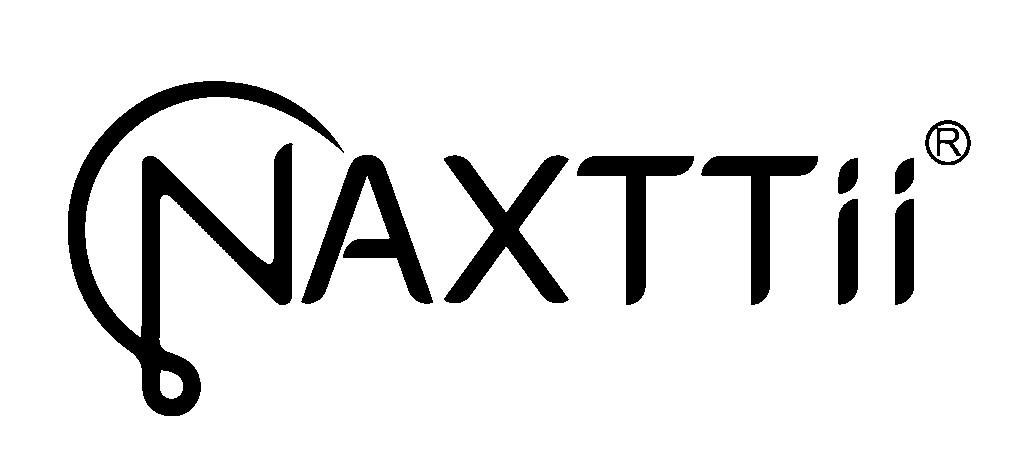Nutritional Value Showdown Apples vs Bananas
Table of Contents
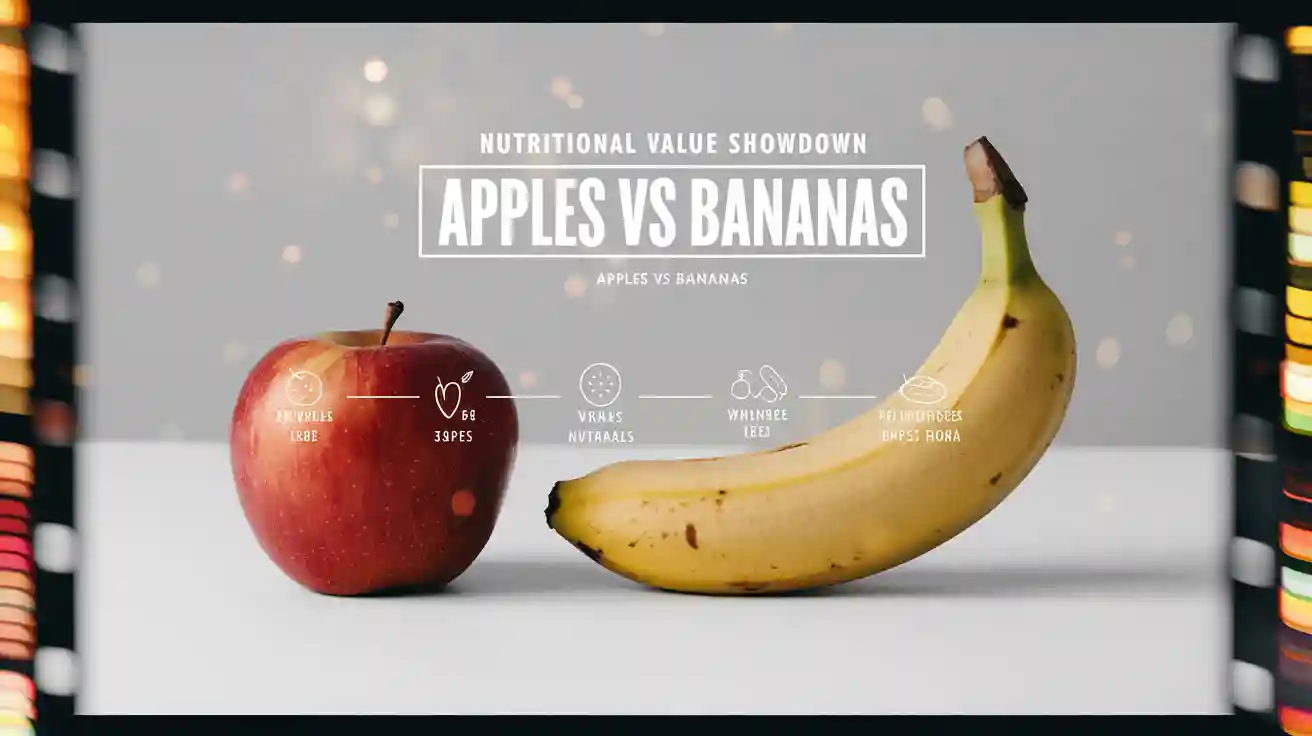
If you want to make smarter choices for your health, you might wonder about the nutritional value of apples versus bananas. These fruits rank among the most popular worldwide. Bananas lead with 115.74 million metric tons produced each year, while apples follow with 86.14 million metric tons. In fact, the global fruit market is set to reach $143.33 billion in 2025. When you compare their nutrition, you see each fruit offers unique benefits for energy, weight management, and blood sugar control.
| Metric | Value |
|---|---|
| Market Size Value In 2025 | $143.33 billion |
| Revenue Forecast In 2034 | $161.37 billion |
| Growth Rate | CAGR of 3% (2025-2034) |
- Bananas are highly available and often the first choice for a quick energy boost.
- Apples come in many varieties and support your nutritional needs in different ways.
Apple vs Banana: Quick Answer
Which Is More Nutritious?
When you compare apple vs banana, you see both fruits offer important nutrients, but each shines in different ways. If you want more fiber and fewer calories, apple is the better choice. Apple contains about 95 calories and 4.4 grams of fiber per medium fruit. Banana gives you more energy with 105 calories and 1.3 grams of protein. Banana also provides higher amounts of potassium, vitamin C, and vitamin B6, which help your muscles and nerves work well.
If your goal is weight loss or blood sugar control, apple stands out. Apple has a lower glycemic index and helps you feel full longer. You get steady energy and fewer cravings. Banana works best when you need a quick energy boost, such as before a workout or during busy days.
Here is a side-by-side look at the nutritional differences between apple and banana:
| Nutrient | Apples (per medium) | Bananas (per medium) |
|---|---|---|
| Calories | 95 | 105 |
| Carbohydrates | 21g | 24g |
| Protein | 0.5g | 1.3g |
| Fat | 0.3g | 0.4g |
| Vitamin C | Lower | Higher |
| Vitamin B6 | Lower | Higher |
| Potassium | Lower | Higher |
| Fiber | 4.4g | 3.1g |
| Water Content | 86% | 75% |
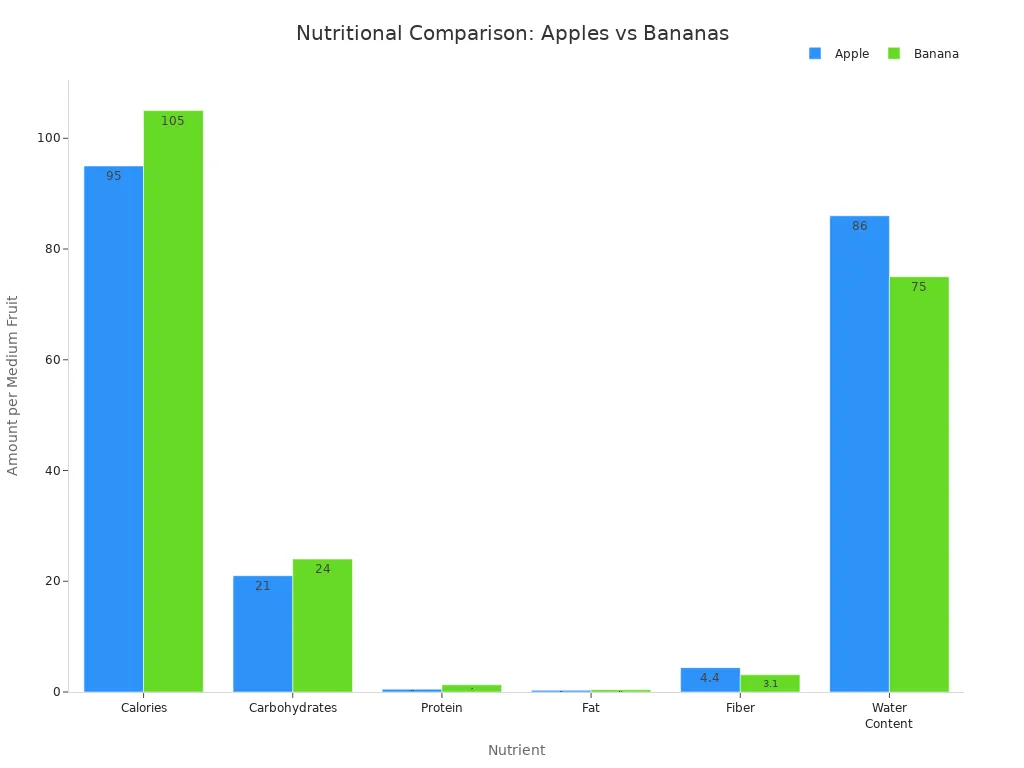
Tip: If you want to manage your weight, choose apple for its high fiber and low calorie value. If you need more potassium or a quick energy source, banana is a smart pick.
Key Differences
You notice several nutritional differences when you look at apple vs banana. Apple contains more water and fiber, which helps your digestion and keeps you hydrated. Banana has more protein, potassium, and vitamin B6, which support muscle function and energy production.
Here are the main differences:
- Apple helps lower serum cholesterol levels and supports weight management.
- Banana is rich in potassium, which helps regulate blood pressure.
- Both fruits contain antioxidants that protect your cells from damage.
| Aspect | Apple | Banana |
|---|---|---|
| Glycemic Index (GI) | Low | Moderate |
| Calories | Fewer | More |
| Recommended For | Weight management, diabetes control | Moderation advised |
You see that apple is better for weight loss and blood sugar control. Banana works well for energy and muscle support. Both fruits add value to your diet, but you should choose based on your health goals.
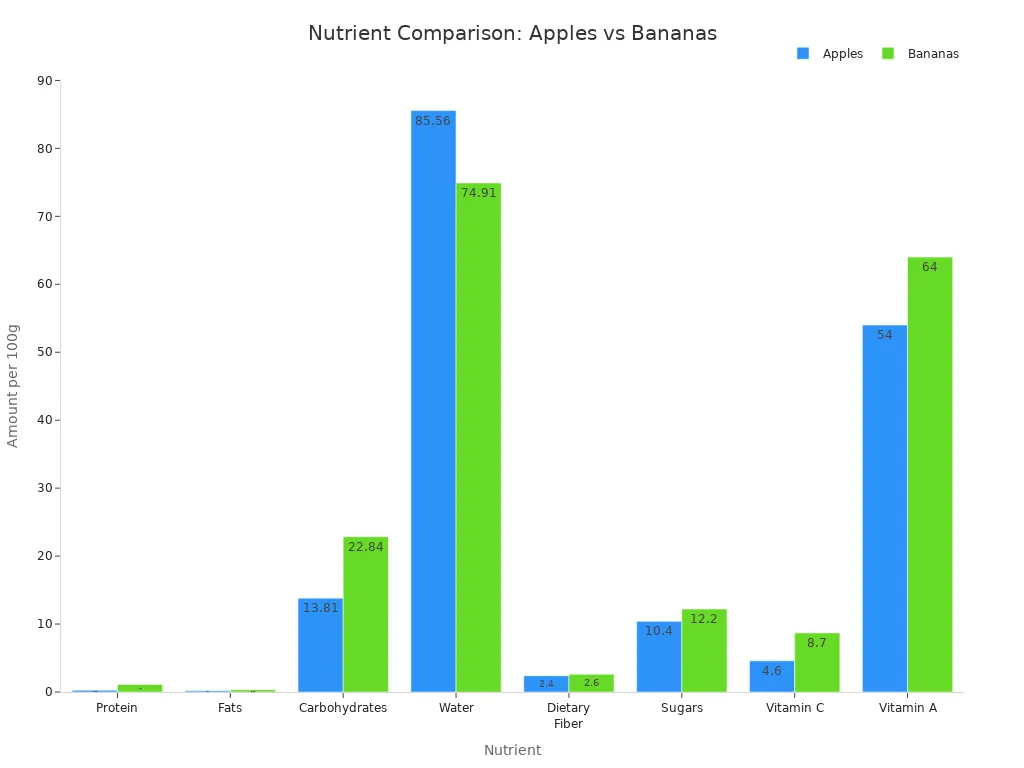
Note: Eating both apple and banana gives you a wide range of nutrients. You get fiber, vitamins, minerals, and antioxidants that help your body stay healthy.
Nutritional Value Comparison
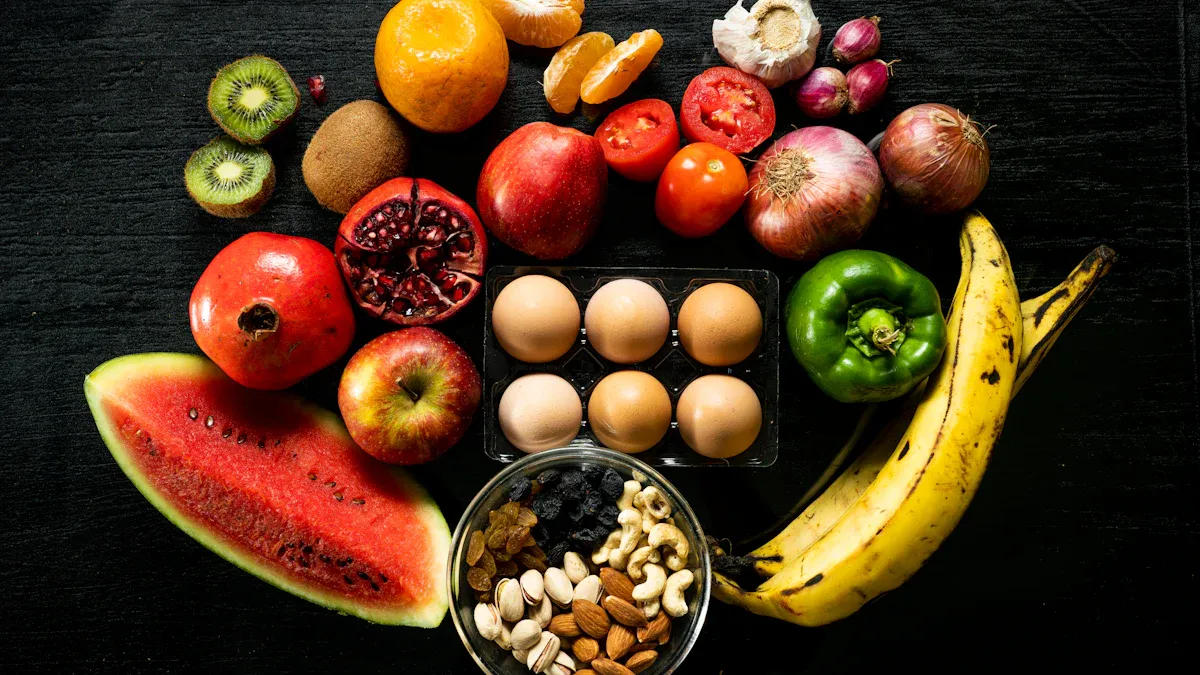
Calories and Carbs
When you look at the nutritional value of apples and bananas, you see differences in calories and carbohydrates. Both fruits give you energy, but the amount varies. Apples have 95 calories per 100 grams, while bananas have 89 calories per 100 grams. The carbohydrate content is also close, with apples providing 25 grams and bananas offering 23 grams per 100 grams.
| Fruit | Calories (per 100g) | Carbohydrates (per 100g) |
|---|---|---|
| Apple | 95 | 25 |
| Banana | 89 | 23 |
You get slightly fewer calories from bananas, but apples have a bit more carbohydrates. If you want a snack with lower calories, banana is a good choice. If you need more carbs for quick energy, apple gives you a little extra.
Tip: Choose apple for a higher carbohydrate boost. Pick banana if you want to keep your calorie intake lower.
Fiber and Sugar
Fiber plays a big role in nutrition and digestive health. You find that apples are high in dietary fiber, with 4 grams per serving. Bananas have 3 grams of dietary fiber per serving. Apples contain pectin, a type of soluble fiber that helps lower cholesterol. Bananas offer inulin and resistant starch, which support gut health.
| Fruit | Fiber Content (grams) | Soluble Fiber Type | Insoluble Fiber Type |
|---|---|---|---|
| Apples | 4 | Pectin | N/A |
| Bananas | 3 | Inulin | Resistant Starch |
You also need to consider sugar content. Apples and bananas both have natural sugars, but the amount can change based on size and ripeness. For example, a 90-gram serving of apple banana contains 2 grams of dietary fiber and 11 grams of sugar. A whole fruit gives you about 1.9 grams of dietary fiber and 8.93 grams of sugar.
| Fruit | Serving Size | Dietary Fiber | Sugar |
|---|---|---|---|
| Apple Banana | 90 g | 2 g | 11 g |
| Apple Banana | 1 fruit | 1.9 g | 8.93 g |
If you want a fruit high in dietary fiber, apple is the better choice. Bananas still provide good fiber content and help with digestion. Apples have a lower sugar content per serving, which is helpful if you watch your sugar intake.
Note: Apples are high in dietary fiber and have less sugar content than bananas. Bananas offer unique fiber types that support your gut.
Vitamins and Minerals
The nutritional comparison between apples and bananas shows differences in vitamins and minerals. Bananas stand out for their potassium content, with 451 mg per serving. Apples provide 195 mg of potassium. Bananas also have more vitamin C and magnesium.
| Fruit | Vitamin C (mg) | Potassium (mg) | Magnesium (mg) |
|---|---|---|---|
| Apple | 8.37 | 195 | N/A |
| Banana | 11 | 451 | 34 |
You get more vitamin C and magnesium from bananas. Apples still offer vitamin C and potassium, but in lower amounts. If you need to boost your potassium intake, banana is the best pick.
Tip: Bananas help your muscles and nerves work well because they are high in potassium. Apples give you antioxidants and phytonutrients that protect your cells.
| Fruit | Antioxidants | Phytonutrients | Health Benefits |
|---|---|---|---|
| Apples | High | Present | Anti-inflammatory, protects against diseases |
| Bananas | Moderate | Present | Rich in potassium, aids in digestive health |
You see that apples have a high level of antioxidants and phytonutrients. These help fight inflammation and protect you from diseases. Bananas support digestive health and give you more potassium.
Glycemic Index and Water Content
The glycemic index (GI) measures how fast a food raises your blood sugar. Apples have a GI of 38, while bananas have a GI of 52. This means apples are less likely to cause a spike in your blood sugar. Bananas can have a moderate effect, but most varieties stay below a GI of 50.
| Fruit | Glycemic Index |
|---|---|
| Apples | 38 |
| Bananas | 52 |
- Apples have a lower glycemic index compared to bananas.
- Bananas are more likely to raise your blood sugar quickly.
- The effect can change if you eat these fruits with other foods.
Water content also matters for hydration. Apples contain about 86% water, while bananas have 75%. If you want a fruit that helps you stay hydrated, apple is the better choice.
Macronutrient Comparison Table
Here is a quick macronutrient comparison for apples and bananas:
| Nutrient | Apples (per 100g) | Bananas (per 100g) |
|---|---|---|
| Calories | 95 | 89 |
| Carbohydrates | 25g | 23g |
| Protein | 0.5g | 1.1g |
| Fat | 0.3g | 0.3g |
| Dietary Fiber | 4g | 3g |
| Sugar Content | 10g | 12g |
| Potassium | 195mg | 451mg |
| Vitamin C | 8.37mg | 11mg |
| Magnesium | N/A | 34mg |
| Water Content | 86% | 75% |
Which Fruit Is Better for Specific Needs?
- If you want a fruit high in dietary fiber, apple is the best choice.
- If you need more potassium, banana gives you a higher value.
- For lower sugar content, apple is better.
- If you want more antioxidants, apple provides a higher nutritional value.
- For hydration, apple has more water content.
- If you need a quick energy boost, banana offers more macronutrients for muscle function.
Remember: The nutritional value of apples and bananas depends on your health goals. You can enjoy both fruits for a balanced nutrition plan.
Apple Benefits
Gut Health
When you eat an apple, you give your gut a boost. Raw apples contain both polyphenols and fiber. These reach your large intestine without breaking down in your stomach. Your gut bacteria then turn these into helpful compounds. This process supports your digestive system and helps keep your gut healthy.
You can see how apples support gut health in the table below:
| Evidence Type | Findings | Implications |
|---|---|---|
| Polyphenols and Fiber | Apples are rich in polyphenols and fiber, which reach the large intestine intact. | They can be converted by gut microbiota into bioactive compounds, influencing gut health. |
| Microbiota Composition | Eating apples changes gut microbiota, increasing good bacteria like Clostridium coccoides. | This supports the production of butyrate, a short-chain fatty acid important for gut health. |
| Human Studies | Two studies showed increased fecal bifidobacteria and reduced harmful bacteria with apple consumption. | Suggests potential for apples to positively influence gut microbiota composition. |
Raw apples offer about 2.21 grams of total fiber per 100 grams. About 30% of this is soluble fiber, such as pectin. Pectin does not break down in your upper digestive tract. Instead, it helps balance your intestinal microbiota. When bifidobacteria in your colon ferment pectin, they create helpful metabolites. These changes can increase the number of good bacteria and boost butyrate levels, which are important for gut health.
Tip: Eating raw apples regularly can help you maintain a healthy gut and improve digestion.
Blood Sugar
Apples also help you manage your blood sugar. The dietary fiber in apples slows down how fast your body absorbs sugar. This means you get a steady release of energy instead of a quick spike. Apples have a low glycemic index, so they do not raise your blood sugar quickly.
Research shows that eating an apple before a meal can help control blood glucose levels. The table below highlights some key findings:
| Evidence Type | Description |
|---|---|
| Study Focus | Looked at how apple consumption affects blood glucose after meals in people with different glucose tolerance. |
| Key Findings | Eating apples before meals may improve blood glucose management due to dietary fiber, fructose, and other compounds. |
| Glycemic Index | Apples are a low GI food, which supports glycemic control. |
| Mechanism | Dietary fiber and polyphenols in apples may slow glucose absorption and insulin secretion. |
| Implications | These findings suggest apples may help people with type II diabetes manage their blood sugar. |
Polyphenols in apples also play a role. They can block certain enzymes and transporters in your gut. This slows down the breakdown and absorption of sugars. Studies show that apple polyphenols can lower blood glucose in people with pre-diabetes. Phlorizin, a special polyphenol in apples, helps block glucose transport, which further supports healthy blood sugar levels.
Note: Adding raw apples to your diet can offer real health benefits for blood sugar control, especially if you want to avoid spikes and crashes.
Banana Benefits
Energy Boost
You often reach for a banana when you need quick energy. This fruit gives you a powerful combination of carbohydrates, fiber, and natural sugars. A medium banana contains 27 grams of carbohydrates, 3.1 grams of dietary fiber, and 105 calories. These nutrients help you stay active and alert during sports or busy days.
| Nutritional Component | Amount per Medium Banana |
|---|---|
| Carbohydrates | 27 g |
| Dietary Fiber | 3.1 g |
| Calories | 105 |
| Potassium | 422 mg |
| Vitamin B6 | 0.43 mg |
| Antioxidant Value | 1,037 µmol TE |
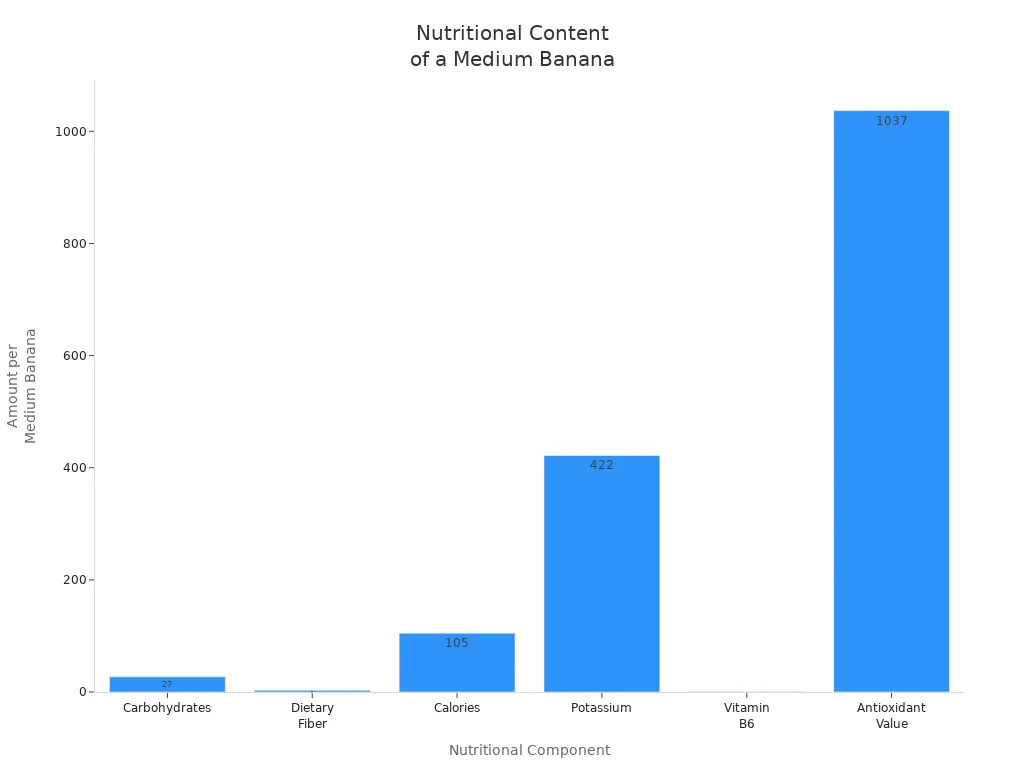
You get a steady supply of glucose because the fiber in banana slows down sugar absorption. This means you avoid sudden spikes and crashes in energy. The natural sugars in raw bananas provide quick fuel, while the fiber helps you maintain energy for longer periods. Athletes often choose banana over sports drinks because it offers similar carbohydrates and calories, plus more antioxidants.
| Nutritional Component | Bananas (per medium banana) | Sports Drink |
|---|---|---|
| Carbohydrates | 27 grams | Similar |
| Calories | 105 | Similar |
| Potassium | 422 mg | Varies |
| Vitamin B6 | 0.43 mg | Varies |
| Antioxidants | High | Lower |
| Glycemic Index | 51 (low-to-medium) | Varies |
Tip: You can use banana as a natural energy snack before or after exercise. It helps you stay energized and supports your overall health.
Studies show that eating banana during endurance activities, like cycling, works as well as sports drinks for performance and recovery. You also benefit from lower inflammation and oxidative stress.
Muscle Function
Banana supports your muscles in several ways. The high potassium content in banana helps your muscles contract and relax properly. You need potassium for effective communication between your brain and muscles. Eating raw bananas gives you 422 mg of potassium per serving, which helps maintain electrolyte balance.
- Potassium in banana is crucial for muscle contraction and relaxation.
- Adequate potassium levels help prevent painful muscle cramps.
- Banana helps replenish glycogen stores after exercise, supporting muscle recovery.
- Compounds in banana may reduce inflammation and muscle soreness.
You may notice that the increase in plasma potassium after eating banana is small and does not happen quickly enough to stop muscle cramps during short sports events. However, regular banana consumption helps your body maintain healthy potassium levels, which supports long-term muscle health.
Note: Banana is as effective as sports drinks for muscle recovery after endurance exercise. You get lower levels of inflammatory markers, which means less soreness and faster recovery.
Research shows that banana helps your body use protein more efficiently, promoting muscle repair. You can choose banana as a post-workout snack to support muscle function and overall health.
Choosing the Right Fruit
For Energy
If you need a quick energy boost, you should reach for a banana. This fruit gives you fast, easily digestible carbohydrates. You can eat it before or after exercise for a steady supply of energy. Bananas also contain more potassium, which helps replace electrolytes you lose when you sweat.
Bananas are a great choice when you need quick, easily digestible energy, such as before or after exercise. They also tend to be easier on sensitive stomachs and offer more potassium, which can help replenish electrolytes lost through sweat.
You can add a banana to your breakfast or snack for an instant pick-me-up.
For Weight Loss
If your goal is weight loss, you want a fruit that keeps you full with fewer calories. Apples and bananas both help, but apples have more fiber, which helps you feel satisfied longer. This can make it easier to stick to your diet and avoid extra snacking.
| Fruit | Calories | Fiber (grams) |
|---|---|---|
| Banana | 105 | 3.1 |
| Apple | N/A | 4.4 |
- Bananas provide 3.1 grams of fiber, which helps in feeling full longer.
- Apples have a higher fiber content at 4.4 grams, potentially offering better satiety.
You can use apples as a snack to support your weight loss plan. Bananas still help, but apples may give you an edge for weight management.
For Workouts
You want the best fuel for your workouts. Bananas give you about 23 grams of carbs per serving, which helps power your muscles. They also provide 360 mg of potassium, which supports muscle function and hydration. Apples have fewer carbs, so bananas work better for intense activity.
- Bananas give you more carbohydrates for energy.
- Bananas are rich in potassium, which helps your muscles work well.
- Bananas contain tryptophan and tyramine, which may affect some people.
You can eat a banana before or after your workout to help your body recover and stay strong.
For Hydration
If you want to stay hydrated, apples are a smart choice. Apples have a higher water content than bananas. You can eat apples during hot weather or after exercise to help your body stay hydrated. Bananas still help with hydration because of their potassium, but apples give you more water.
You can include both fruits in your diet for the best results. Apples help with hydration, while bananas support electrolyte balance.
For Blood Sugar Management
If you have concerns about blood sugar, apples are a good option. They have high fiber and pectin, which help control glucose absorption. Bananas, especially when unripe, also help because they have resistant starch and soluble fiber.
| Fruit | Benefits for Diabetes |
|---|---|
| Apples | – High in fiber, helps regulate glucose absorption |
| – Contains pectin, beneficial for blood sugar control | |
| – Provides steady energy release | |
| Bananas | – Contains soluble fiber, helps slow digestion |
| – Low glycemic index, but can cause spikes if overripe | |
| – Resistant starch aids in blood sugar management |
You can choose apples for steady energy and better blood sugar control. Bananas work well if you pick less ripe ones.
Tip: You can enjoy both apples and bananas as part of a healthy diet. Choose based on your needs for energy, weight loss, workouts, hydration, or blood sugar management.
Apple vs Banana: Summary Table
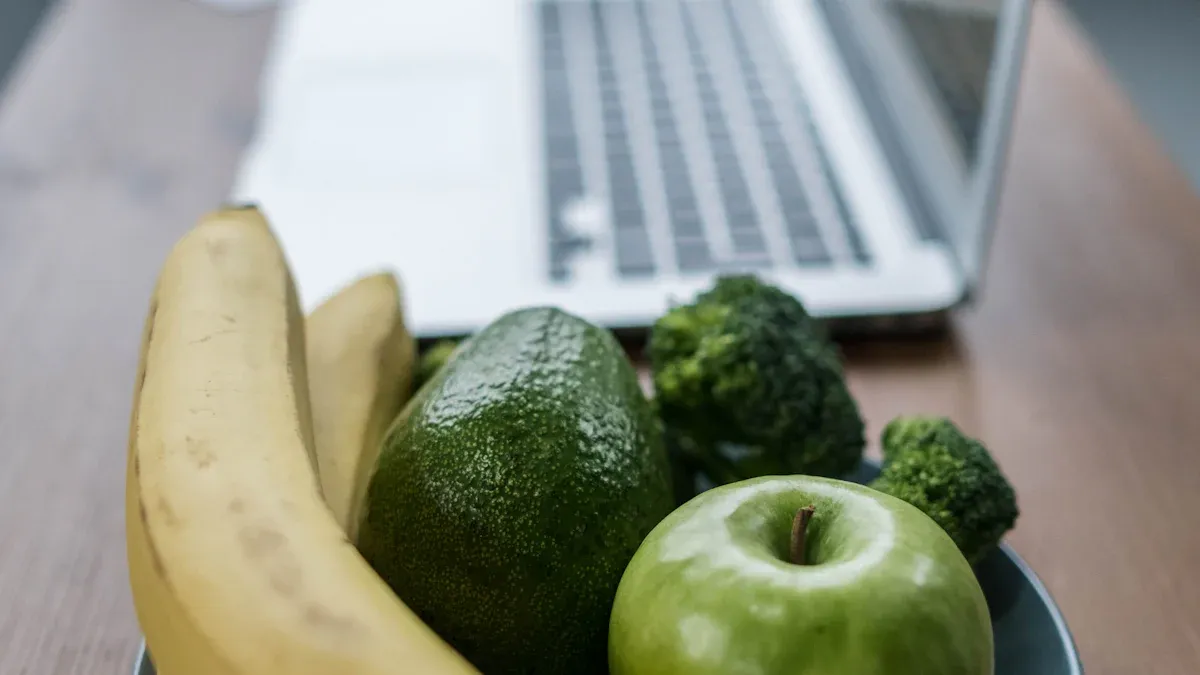
When you want to compare the nutrition of apple and banana, a summary table helps you see the facts at a glance. You can use this table to decide which fruit fits your needs best. Each fruit brings something special to your diet.
| Nutrient | Apple (per 100g) | Banana (per 100g) |
|---|---|---|
| Calories | 64 Cal | 92 Cal |
| Fiber | 2.4 g | 2.6 g |
| Sugar | 10 g | 12 g |
| Potassium | 41.1 mg | 55.7 mg |
| Vitamin C | 40.0 mg | 25.0 mg |
| Vitamin A | Present | Not listed |
| Vitamin B6 | Not listed | Present |
You can see that apple has fewer calories and less sugar than banana. Banana gives you a bit more fiber and potassium. Both fruits offer vitamin C, but apple contains more. If you want vitamin A, apple is the better choice. Banana stands out for vitamin B6, which helps your body use energy.
Here is another way to look at the nutrition for a typical serving:
| Fruit | Serving Size | Calories | Fiber | Potassium |
|---|---|---|---|---|
| Apple with skin | 1 med, 182 g | 95 | 4.4 g | 195 mg |
| Banana | 1 med, 118 g | 105 | 3.1 g | 422 mg |
- Apple gives you more fiber per serving, which helps you feel full.
- Banana provides more potassium, which supports your muscles.
Tip: If you want a snack with fewer calories and more fiber, choose apple. If you need more potassium for muscle health, banana is a smart pick.
You can use this summary table to make healthy choices every day. Both apple and banana fit well in a balanced diet. You get vitamins, minerals, and energy from each one. Try to enjoy both fruits to get the most benefits.
You see clear differences between apples and bananas. Apples give you more fiber and antioxidants, while bananas offer higher potassium and quick energy.
| Fruit | Calories | Carbohydrates | Fiber | Protein | Fat | Potassium | Vitamin C |
|---|---|---|---|---|---|---|---|
| Banana | 105 | 26.9 g | 3.07 g | 1.29 g | 0.39 g | 422 mg | 10.3 mg |
| Apple | 122 | 29.6 g | 4.2 g | 0.34 g | 0.3 g | 208 mg | 9.2 mg |
Experts say eating both fruits together can boost your health more than eating just one.
- Apples and bananas support heart health, digestion, and energy.
- You can add both to your meals for a balanced diet and better well-being.
FAQ
Can you eat apples and bananas together?
Yes, you can eat apples and bananas at the same time. You get more vitamins, minerals, and fiber when you combine both fruits. Your body benefits from a wider range of nutrients.
Which fruit is better for breakfast?
Banana gives you quick energy in the morning. Apple helps you feel full longer. You can choose either fruit or eat both for a balanced breakfast.
Do apples or bananas cause weight gain?
Neither apple nor banana causes weight gain when you eat them in moderation. Both fruits have low calories and high fiber. You can include them in your diet without worry.
Are apples or bananas safe for people with diabetes?
Apple is a better choice for blood sugar control. It has more fiber and a lower glycemic index. Banana is safe if you eat it in small amounts, especially when it is less ripe.

Poseidon
Master of Nutritional Epidemiology, University of Copenhagen, Herbal Functional Nutrition Researcher
Focus: The scientific application of natural active ingredients such as Tongo Ali, Horny Goat Weed, and Maca to sexual health and metabolic regulation.
Core Focus:
Men: Use a combination of Tongo Ali (an energizing factor) + Maca (an energy reserve) to improve low energy and fluctuating libido.
Women: Use a combination of Horny Goat Weed (a gentle regulator) + Maca (a nutritional synergist) to alleviate low libido and hormonal imbalances.
Stressed/Middle-Aged Adults: This triple-ingredient synergy supports metabolism, physical strength, and intimacy.
Product Concept:
Based on traditional applications and modern research (e.g., Tongo Ali promotes testosterone-enhancing enzyme activity, and icariin provides gentle regulation), we preserve core active ingredients and eschew conceptual packaging—using natural ingredients to address specific needs.
Simply put: I'm a nutritionist who understands "herbal actives." I use scientifically proven ingredients like Tongo Ali, Epimedium, and Maca to help you make "sexual health" and "nutritional support" a daily routine.
